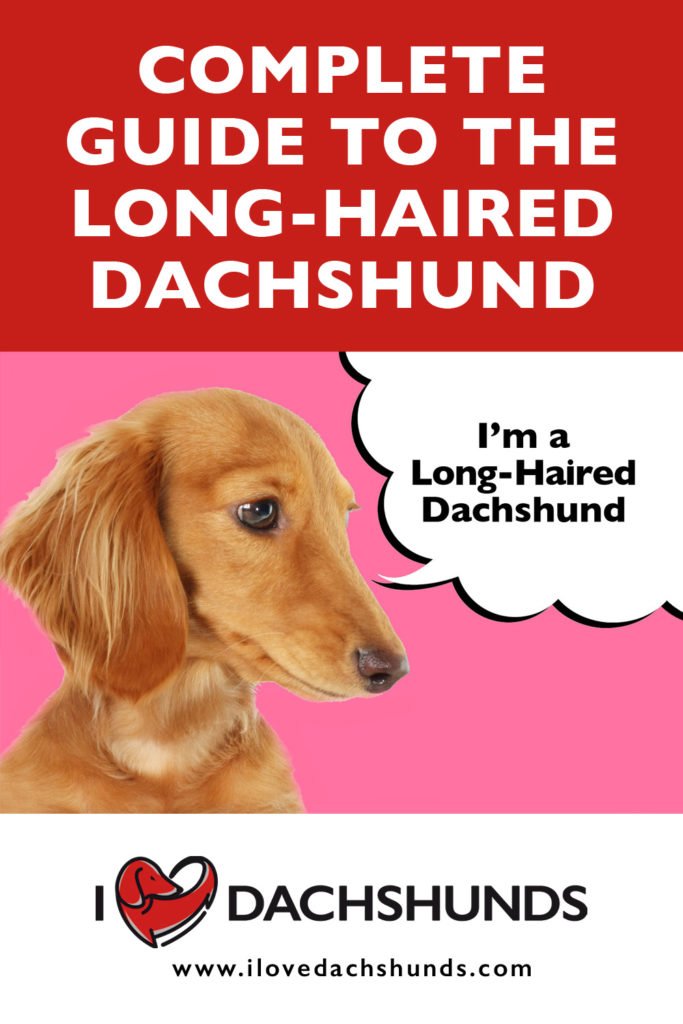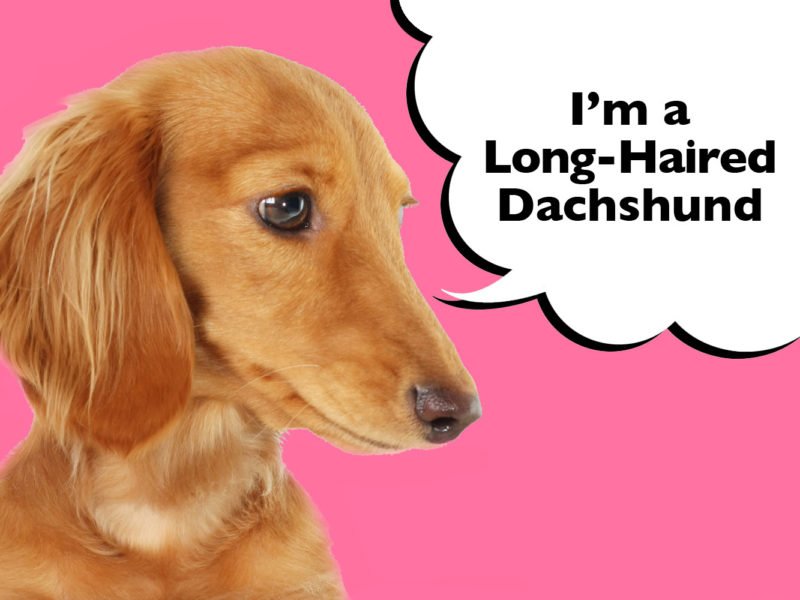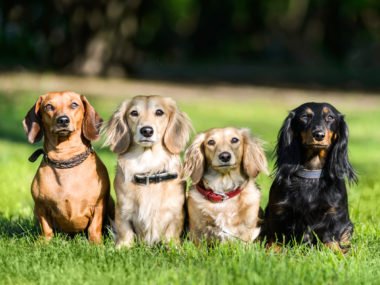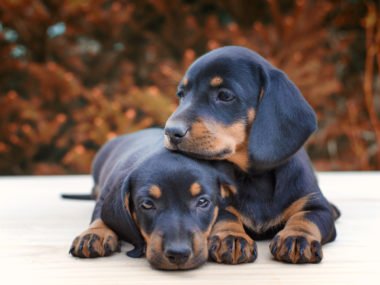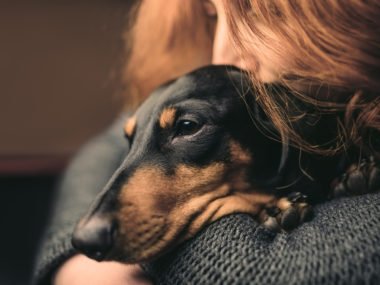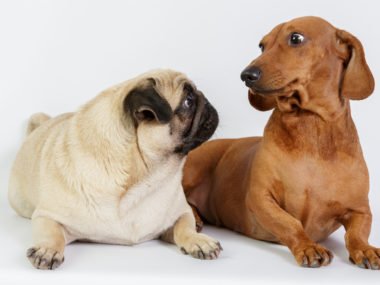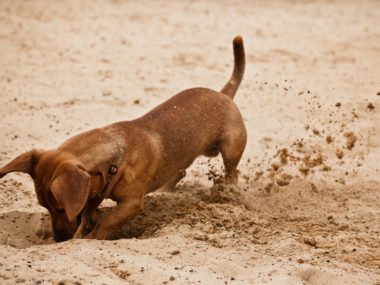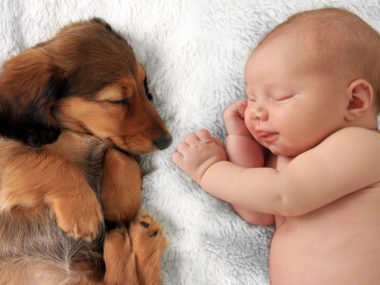Do you have a Long-Haired Dachshund or are you thinking about getting one? Are you interested to find out more about the breed? Here’s everything you need to know about the Long-Haired Dachshund breed.
What is a Long Haired Dachshund? A Long-Haired Dachshund is a short-legged, long-bodied dog breed with a long, fluffy, silky coat, big feathery ears, long nose, deep muscular chest and a loud bark. Known to be stubborn, spirited and courageous, they were originally bred in Germany to hunt badgers.
Read on to find out more about the Long-Haired Dachshund breed, including colours, coat, sizes, weight, personality, temperament, suitability, activity levels, training, considerations, health problems – and much more!
Table of Contents
- Long Haired Dachshund History
- Long Haired Dachshund Appearance
- Long Haired Dachshund Coat
- Long Haired Dachshund Colours
- Long Haired Dachshund Sizes
- Long Haired Dachshund Weight
- Long Haired Dachshund Personality
- Long Haired Dachshund Temperament
- Long Haired Dachshund Suitability
- Long Haired Dachshund Training
- Long Haired Dachshund Activity Levels
- Long Haired Dachshund Considerations
- Long Haired Dachshund Health Problems
- Long Haired Dachshund Cost
- Long Haired Dachshund Life Expectancy
- What do I do next?
This article is based on research and personal experience as a Dachshund owner of 10+ years. I’m not a Vet, qualified dog trainer or dog behaviourist.
Long Haired Dachshund History
Long-Haired Dachshunds were originally bred in Germany as hunting dogs.
They used to dart through the undergrowth and dig down into burrows to flush out burrow dwelling animals like badgers and rabbits for hunters!
The German word ‘Dachshund‘ actually translates as ‘Dachs’ meaning ‘badger’ and ‘hund’ meaning ‘dog’ – Badger Dog!
Dachshunds are said to have been around since the 15th century. However, it wasn’t until the 17th century that Long-Haired Dachshunds started being used as hunting dogs.
Long-Haired Dachshunds are an official dog breed recognised by the American Kennel Club (AKC) and UK Kennel Club (KC).
Click here to read the full history on Dachshunds!
Long Haired Dachshund Appearance
The Long-Haired Dachshund originally came about by breeding Smooth-Haired Dachshunds with either Long-Haired German Pointers or Long-Haired Spaniels.
Long-haired Dachshunds have the same long bodies and short legs as Smooth-Haired and Wire-Haired Dachshunds, but with a long, fluffy, wavy coat, that’s fine and silky in texture.
They also have long, feathered hair on their big floppy ears, which you won’t find on Smooth-Haired or Wire-Haired Dachshunds.
To find out what a purebred Dachshund looks like, click here!
Long Haired Dachshund Coat
Long-Haired Dachshunds have long, wavy coats that are silky in texture and need regular grooming.
Out of the three types of Dachshunds, Long-Haired Dachshunds require the most amount of maintenance.
Grooming
All Long-Haired Dachshunds need regular brushing to keep their coat healthy and tangle free.
This’ll also help to stimulate the natural oils that help keep their coat silky!
Long-Haired Dachshunds do shed hair throughout the year, but daily brushing will get rid of any dead fur and minimise shedding.
Even though Smooth and Wire-Haired Dachshunds only need a bath every couple of months, Long-Haired Dachshunds may need to be bathed more often.
Their long, wavy coat can pick up dirt and get knotted and matted easily, especially around the ears and feet.
Click here to find out how to groom a Long-Haired Dachshund
Allergies
Long-Haired Dachshunds are not hypoallergenic, which means they could be problematic for allergy sufferers.
Although, symptoms can often be minimised with regular cleaning, vacuuming and washing of dog bedding.
Out of the three types of Dachshunds, Wire-Haired Dachshunds are said to be the best for people with pet allergies.
They don’t release as much dander as Smooth and Long-Haired Dachshunds do.
Although, that will of course be very dependent on each individual person.
Smell
Interestingly, Long-Haired Dachshunds don’t tend to have much of a doggy smell, compared with other dog breeds.
However, all Dachshunds are known for rolling in poop and other gross things they find outside!
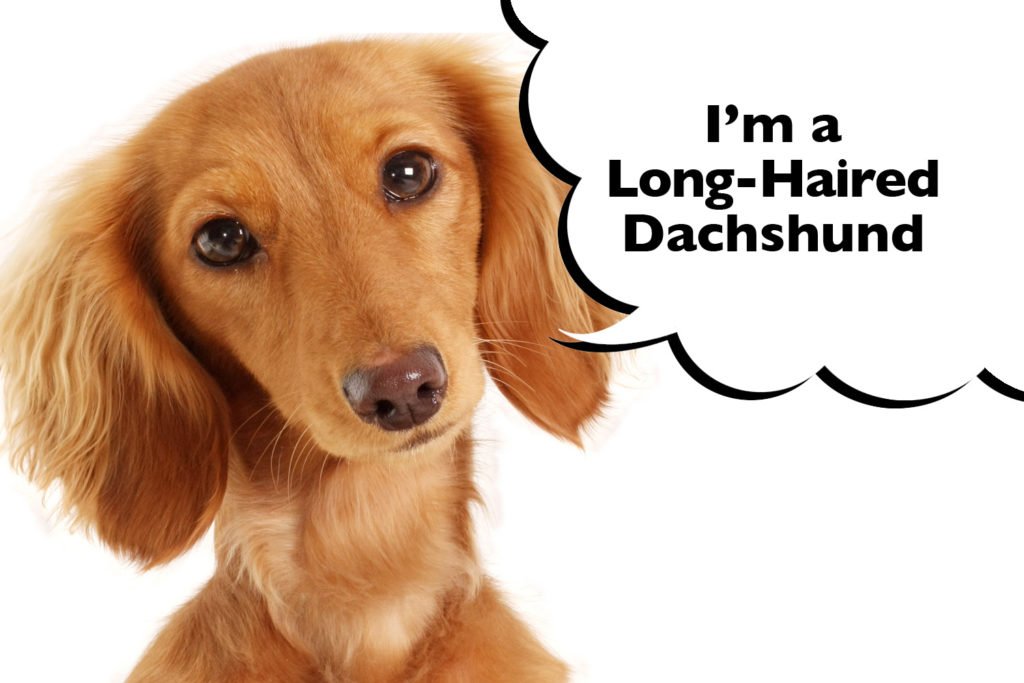
Long Haired Dachshund Colours
Long-Haired Dachshunds can have many coat colours including Black and Tan, Brindle, Red, Shaded Red, Chocolate and Tan, Chocolate Dapple and Tan and Silver Dapple and Tan.
Non-Breed Standard Colours
In addition to the standard colours, you may see Long-Haired Dachshunds in many non-breed standard colours too.
For example, Cream, Black and Cream, Blue and Cream, Blue and Tan, Chocolate and Cream, Chocolate and Tan, Isabella and Cream, Isabella and Tan, Shaded Cream, Silver and Cream and Silver and Tan.
Long-Haired Dachshunds can also have brindle, dapple and piebald coat patterns within some of these non-breed standard colours too.
Dilute Colours
There’s growing research to suggest that Long-Haired Dachshunds with ‘Blue‘ and ‘Isabella‘ coat colours can have more serious health issues.
For example, colour dilution alopecia, skin infections, skin cancer and other kinds of skin problems – so it’s worth bearing that in mind!
Long Haired Dachshund Sizes
Long-Haired Dachshunds come in two different sizes. There are Miniature Long-Haired Dachshunds and Standard Long-Haired Dachshunds.
Miniature Long-Haired Dachshunds are around 13-18cm in height to their withers (which is the highest point at the top of their shoulder blades). Standard Long-Haired Dachshunds are around 20-22cm in height to their withers.
However, these are Breed Standard measurements. So you may have a large Miniature Long-Haired Dachshund or a small Standard Long-Haired Dachshund – and that’s completely normal!
Some Dachshund owners refer to the in-between sizes as ‘Tweenies’.
This isn’t an officially recognised dog breed. It’s just a fun name owners use to describe Long-Haired Dachshunds that don’t quite fit into either size category.
Click here to find out the difference between Miniature and Standard Dachshunds!
Full Grown
You should know how big your Long-Haired Dachshund will be by the time they get to 12 months old. Although they can keep filling out and gaining weight for around 18-24 months.
Long Haired Dachshund Weight
Miniature Long-Haired Dachshunds weigh less than 11 pounds and Standard Long-Haired Dachshunds weigh between 16 and 32 pounds.
However, the size and shape of Long-Haired Dachshunds can vary quite a lot.
Some Long-Haired Dachshunds can be bigger than the breed standard and others can be smaller. This makes it hard to define them just by what the scales say.
Sometimes it’s better to just examine your Long-Haired Dachshund yourself.
A healthy weight Long-Haired Dachshund will have a noticeable tuck to their waist when viewed from above.
You should also be able to feel their ribs if you run your hands over their ribcage, and there should be no excess fat around their shoulder blades or neck area.
If you can’t see a visible tuck to their waist, your Long-Haired Dachshund may need to lose weight.
If you can see their ribs really clearly, then they may need to gain weight.
Keeping your Long-Haired Dachshund at a healthy weight is really important because Dachshunds are prone to obesity.
Any extra weight could also put added pressure on your Long-Haired Dachshund’s weak and fragile back.
If you’re unsure what weight your Long-Haired Dachshund should be, just check with your Vet!
To find out the ideal weight for your Long-Haired Dachshund, click here!
To help your Long-Haired Dachshund lose weight, click here!
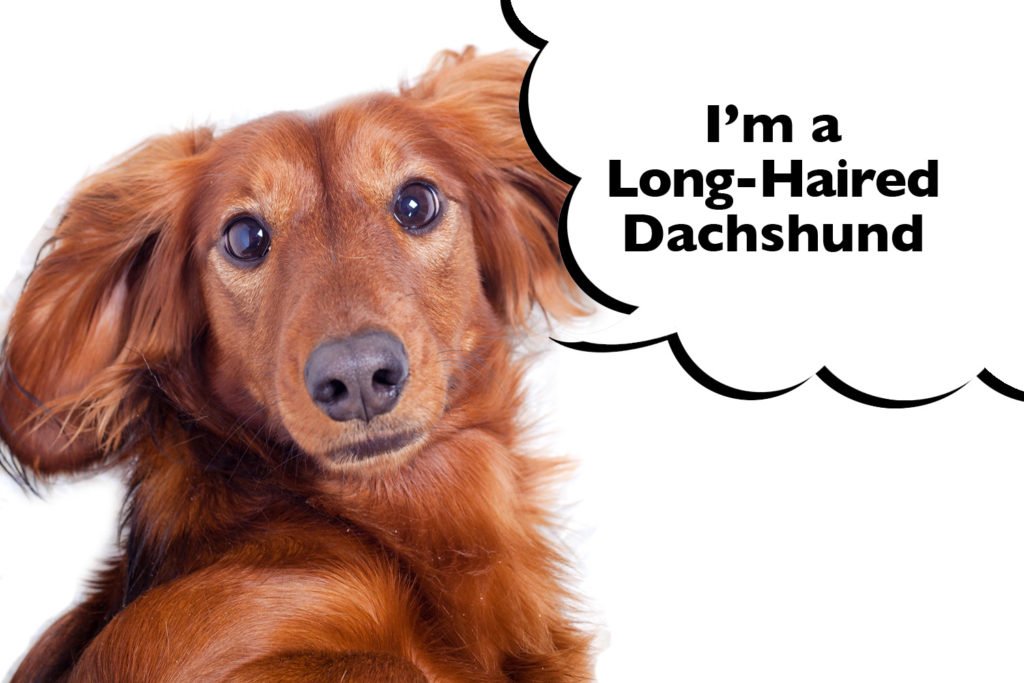
Long Haired Dachshund Personality
Out of the three types of Dachshunds, Long-Haired Dachshunds are known for being slightly quieter and more gentle with some Spaniel-like qualities.
Long-Haired Dachshunds can also be:
- Stubborn
- Loyal
- Affectionate
- Gentle
- Noisy
- Energetic
- Confident
- Courageous
- Independent
- Smart
- Greedy
- Territorial
- Playful
- Fun
- Loving!
One of the most recognisable traits you’ll notice in a Long-Haired Dachshund is ‘loyalty’.
They tend to attach themselves intensely to one owner and follow them wherever they go (even to the loo!).
As much as all this love and attention is sweet and endearing, you don’t want to indulge it too much.
Otherwise, your Long-Haired Dachshund could end up with separation anxiety when you do need to leave your house.
In general, Long-Haired Dachshunds are devoted and sweet natured dogs that are full of personality and adorable charm.
Click here to find out more about Long-Haired Dachshund traits!
Long Haired Dachshund Temperament
The majority of Long-Haired Dachshunds are friendly once they get to know you.
Long-Haired Dachshunds tend to be very gentle and loving, as long as they’ve been socialised as puppies, well trained, and introduced to people and children in the right way.
Long-Haired Dachshunds were originally created when Smooth-Haired Dachshunds were bred with either Long-Haired German Pointers or Long-Haired Spaniels to create that long, silky coat.
It’s thought that this distant heritage makes Long-Haired Dachshunds slightly more gentle, sensitive and friendly, than Smooth or Wire-Haired Dachshunds are.
However, some Long-Haired Dachshunds (although not all!) may be a bit too overly-protective of their owners.
They may bark or growl at strangers or young children if they feel scared, jealous, protective, anxious or threatened in any way.
This can be worked on with dog training or help from a dog behaviourist, and should improve with commitment and time.
However, as with all dogs, you should always take care around children. Especially if the children are too young to know how to play with your Long-Haired Dachshund sensibly.
Long-Haired Dachshunds may also be protective of the garden or yard too (they’re amazing watchdogs!).
They may bark at anything that moves outside (including leaves and squirrels!), and eat anything they find or catch too!
Long-Haired Dachshunds may be domesticated dogs these days, but that natural ability to hunt and stay alert never leaves them!
Not all Long-Haired Dachshunds will be feisty or aggressive in nature. Most will be loving, sweet, and gentle dogs that are truly devoted to their owners and families.
Long Haired Dachshund Suitability
Most Long-Haired Dachshunds are perfectly suited for family living.
Children
As pack dogs, Long-Haired Dachshunds love being part of a family and are generally great with children, as long as the children play nicely with them.
However, Long-Haired Dachshunds should never be left alone with a baby or child. If you need to leave the room, either crate or lock them in another room for a short time.
Separation Anxiety
In general, Long-Haired Dachshunds don’t tolerate being left on their own too long.
If you go out for more than about 4 hours at a time, it can sometimes be problematic. In fact, some Long-Haired Dachshunds don’t like being left alone at all.
Separation anxiety can be a really upsetting problem for many Long-Haired Dachshunds (although not all!).
This is where they get really stressed and anxious, potty on the floor, bark the whole time and are destructive when you leave the house.
If you have a full-time job, this does need to be a consideration, but that’s not to say you can’t make it work.
You may need to do some dog training or ask someone to call in and let your Long-Haired Dachshund out during the day.
Dogs
If you’re out at work all day, it may help to have two Dachshunds to keep each other company.
Long-Haired Dachshunds need companions but don’t mind whether they’re hanging out with humans or dogs!
However, don’t ever get another dog to fix the problems of the first. This could really backfire and you may end up with two anxious Dachshunds!
Most Long-haired Dachshunds get on well living with other dogs, but this does depend on each individual dog in the home.
Some Long-haired Dachshunds can get territorial and jealous, and might not be happy about sharing their owner with another dog.
Click here to find out how to introduce Long-Haired Dachshunds to other dogs
Cats
Cats can be slightly more challenging.
It’s possible to train some Long-Haired Dachshunds to accept living with cats but, unfortunately, it won’t always work!
Long-Haired Dachshunds have a strong prey drive, so it’ll depend on the age of each pet and their history and status in the home.
It’ll be easier to introduce a Long-Haired Dachshund puppy into a cat’s home, than to bring a cat into a Long-Haired Dachshund’s home.
Click here to find out how to introduce Long-Haired Dachshunds to cats
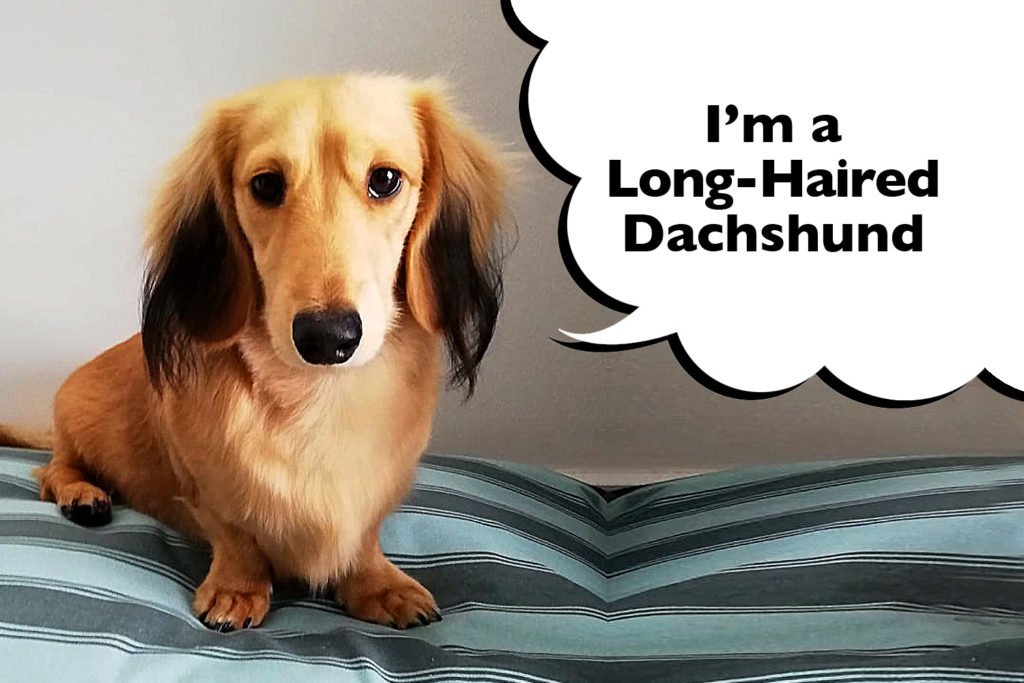
Long Haired Dachshund Training
Due to their stubborn nature and independent spirit, Long-Haired Dachshunds are one of the hardest dog breeds to train.
However, they’re also extremely smart, willing to learn, and eager to please!
This basically means Long-Haired Dachshunds CAN be trained but it’ll take patience, consistency, commitment and time.
The most challenging areas of dog training will likely be:
Long-Haired Dachshunds can be stubborn so it’s often a battle of wills to see who will give in first.
You just have to stay committed and consistent – and put in the time and effort it takes!
Discipline
To discipline your Long-Haired Dachshund, it’s important to use positive reinforcement training because this helps to build trust.
This is where you ignore or calmly correct your Long-Haired Dachshund when they get something wrong, and give treats and belly rubs when they get something right.
Click here to find out more about how Positive Reinforcement Training works!
Long Haired Dachshund Activity Levels
A Long-Haired Dachshund’s activity levels will change, depending on their age.
Puppy Stage
Even though very young Long-Haired Dachshund puppies might sleep peacefully for 18 hours a day – that doesn’t last long!
Overall, the puppy stage will be very full-on and active, and will keep you on your toes all day long!
Looking after a Long-Haired Dachshund puppy can be really hard work and demanding.
Like all puppies, they need your time, plenty of love, lots of attention and ongoing training too.
Exercise
A Long-Haired Dachshund puppy also needs daily exercise.
However, they mustn’t be over-exercised for the first 12 months or it could impact their growth and development.
The general rule to stick to is ‘5 minutes formal exercise per month of age’.
For example, a 3 month old Long-Haired Dachshund puppy would need 15 minutes of exercise every day, and a 4 month old puppy would need 20 minutes – and so on.
This formal exercise doesn’t include playing in the garden or yard off-leash. That can be in addition to this.
As adults, Miniature Long-Haired Dachshunds need at least 30 minutes of exercise a day and Standard Long-Haired Dachshunds need 60 minutes or more.
Click here to find out how to exercise your Long-Haired Dachshund
Sleep
If you give a Long-Haired Dachshund the right amount of exercise and mental stimulation each day, most will happily sleep for about 12–14 hours a day.
It just depends how old your Long-Haired Dachshund is, how much exercise they get, how much you play with them, and whether they have any health problems.
Activity
All in all, most adult Long-Haired Dachshunds only need moderate amounts of activity and will happily adapt to how you live.
This makes Long-Haired Dachshunds well-suited for most people and families, including those that are retired.
Long Haired Dachshund Considerations
Long-Haired Dachshunds tend to be stubborn dogs that don’t always do what they’re told.
So there are some things to consider if you’re thinking of getting a Long-Haired Dachshund!
Puppy Stage
The puppy stage can be pretty intense! Not only do Long-Haired Dachshund puppies require a lot of time and effort, but they’re also notoriously hard to train.
Barking
Most Long-Haired Dachshunds bark a lot too, although they don’t tend to be quite as noisy as Smooth and Wire-Haired Dachshunds are.
However, barking can be one of the biggest problems many owners face.
The constant noise can annoy the neighbours and, if you work during the day, it can be a real challenge to overcome.
Click here to find out how to train a Dachshund to stop barking
Attention
Long-Haired Dachshunds also tend to be quite sensitive and needy, demanding constant love, attention and time.
If you give them too much attention, it can sometimes cause separation anxiety when you do need to leave the house.
Click here to find out why Dachshunds are so needy
Digging
Due to their hunting heritage, Long-Haired Dachshunds are also natural diggers.
They may dig up your flowerbeds or lawn, and try to dig their way under your fence too!
Unfortunately, Long-Haired Dachshunds have very little road sense. That means you need to make sure your garden or yard is dog proof and fully secure.
Click here to find out why Dachshunds dig and how to stop it
Scavenging
Long-Haired Dachshunds will eat things they find on the ground outside too (including poop!).
They’re natural born hunters with a strong prey drive, and that instinct will often override anything you say!
This means you need to keep a close eye on your Long-Haired Dachshund if they’re outside in the garden or yard.
Back Disease
The discs in a Long-Haired Dachshund’s spine start to deteriorate at a younger age than other dog breeds.
This inherited weakness in their back makes them prone to Intervertebral Disc Disease (IVDD).
IVDD is an extremely painful and debilitating back condition that can sometimes lead to partial or full paralysis.
Treatment for IVDD is extremely costly so a good pet insurance policy needs to be in place.
This means that Long-Haired Dachshunds can often be more expensive to insure than other dog breeds.
There are some lifestyle changes you can make that may help to reduce the risk of IVDD.
However, back problems are something you need to be prepared for if you bring a Long-Haired Dachshund into your life and home.
Time
Owning a Long-Haired Dachshund can take up a lot of your time.
They may not need huge amounts of exercise, but they’re inquisitive little dogs that’ll keep you on your toes!
Click here to find out the pros and cons of owning a Long-haired Dachshund

Long Haired Dachshund Health Problems
Long-Haired Dachshunds can be prone to many health conditions including back problems, eye conditions, knee dislocation, hip dysplasia, hypothyroidism, obesity, allergies (skin and environmental) and other skin conditions.
Intervertebral Disc Disease (IVDD)
Like all Dachshunds, Long-Haired Dachshunds are also prone to Intervertebral Disc Disease (IVDD).
This is an extremely painful and debilitating back condition that is said to affect around one in four Dachshunds.
In some cases, IVDD can sadly lead to partial or full paralysis.
This means you’ll need to install stair gates to stop your Long-Haired Dachshund going up and down, and to put dog ramps against your sofa to stop them jumping on and off.
You also need to make sure everyone in your family knows how to lift and hold your Long-Haired Dachshund the right way too.
Neutering
There’s a link between early neutering and IVDD too.
According to research, if you neuter or spay your Long-Haired Dachshund before they reach 12 months old, it can increase the risk of IVDD.
IVDD is one of the most challenging health conditions you will face with your Long-Haired Dachshund, but there are some lifestyle changes you can make that may help to reduce the risk.
Click here to find out how to reduce the risk of IVDD in Long-Haired Dachshunds
Long Haired Dachshund Cost
On average, a Kennel Club registered Long-Haired Dachshund costs around £1500-£3000 or $2000-$4000.
The popularity and increase in demand for Long-Haired Dachshunds has significantly increased the price in recent years!
Dog breeders can charge what they want for Long-Haired Dachshund puppies and what they feel is fair!
Click here to find out why Dachshunds are so expensive!
Long Haired Dachshund Life Expectancy
On average, Miniature Long-Haired Dachshunds live for about 12-16 years, and Standard Long-Haired Dachshunds live for about 12-14 years.
Miniatures tend to live a little longer than standards because they’re slightly less prone to back problems.
Long-Haired Dachshunds generally live a long life when compared with other dog breeds.
In fact, many owners in Facebook Groups say their Long-Haired Dachshunds lived as long as 18 or more years!
Click here to find out how to care for your new Long-Haired Dachshund puppy!
So, there you have it! Everything you need to know about the Long-Haired Dachshund breed. Half as high as they are long, with more personality and adorable charm than you could possibly ever wish for! You’ll never be short of love and companionship with a Long-Haired Dachshund by your side!
What do I do next?
If you read all the way to the end of this article, you’re exactly the sort of person I’d LOVE to join my Facebook Group. Your support for my blog means everything to me so, if you found this article helpful, please kindly share below. Thank you! 💋
